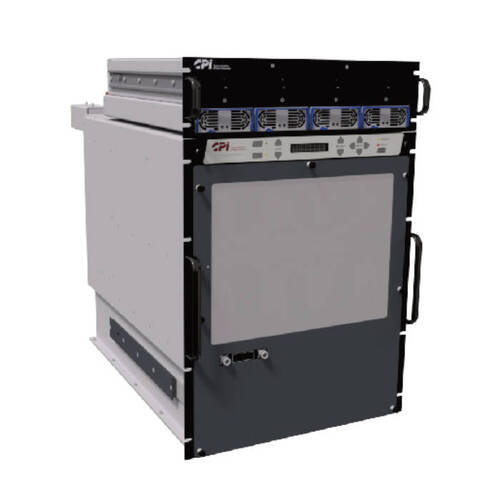CPI ModuMAX SSPA Systems - C, X, and Ku-Bands
Satellite communications providers face significant risk when the link to a satellite is disrupted. Critical applications go offline, customers lose confidence, and revenue is lost as providers scramble to recover the link. Thus, most satellite earth stations employ brute-force redundancy, i.e. two of everything, to reduce the risk, but at significant cost and increased complexity. When the final amplifier stage was a single tube and thus a single point failure, having a second amplifier immediately available was a pragmatic solution. However, with the demonstrated viability and practicality of solid state amplifiers, non-brute-force redundancy solutions offer significant cost and performance advantages.
Built-in Redundancy
Solid-state power amplifiers (SSPAs) consist of multiple transistors in parallel, and consequently contain built-in redundancy. Utilizing multiple parallel RF modules, power supplies and cooling fans, CPI ModuMAX SSPAs are extremely reliable and fault-tolerant. With the ModuMAX series, one fault-tolerant SSPA can replace two conventionally designed high power amplifiers yielding significant installation savings and reduced operating costs.
Due to its internal architecture and unique operating features such as single-module failure compensation and configurable power, ModuMAX is designed to eliminate the need for a redundant, stand-by unit in most applications.
RF Plug-In Modules
The RF plug-in modules are conveniently accessible from the front panel. Summary module status is visually indicated by a multicolor indicator on each module with detailed information available at the control panel display and via remote M&C.
Failure of a single module causes a drop of approximately 1.2 dB in output power without the momentary loss of signal caused by redundant switchover systems. Defective RF modules can be hot-swapped while the SSPA continues to operate. Since they contain only a fraction of the RF power transistors in the SSPA, spare RF modules are affordable.
Easy to Operate and Maintain
ModuMAX SSPAs are designed to be easy to operate and maintain. All features can be fully remote controlled through standard RS-232/-422/-485 and network interfaces. For quick and easy manual access, the most commonly used controls are located on the front panel.
Most maintenance can be performed safely while the SSPA continues to operate. Any of the eight fans in the air-cooling system can be easily removed and replaced, without ever taking the SSPA off-line. Even the power supply modules are redundant and hot swappable.
Configurable Power
ModuMAX SSPAs combine the RF output power from eight identical, fully interchangeable RF plug-in modules (16 in a phase-combined system) to obtain the rated power capacity. These modules can be individually turned on or off via either local or remote control. Installations can exploit this feature to reduce prime power consumption during times when the required RF output power is lower than the maximum linear power capacity of the amplifier. This ability to adjust the number of enabled RF modules to match the output power requirement is called configurable power.
Additionally, the amplifier modules can also be employed in an N+X redundancy configuration where, in the event of a fault occurring in the online modules, the available spare modules can be brought on line rapidly via M&C.
Configurable power is implemented by determining the minimum number of modules that must be enabled to provide the required RF output power. Any modules not needed to support the system traffic load are deactivated, either locally or via one of the remote interfaces. When the system is operating, the remote M&C system monitors the ModuMAX for faults. If the M&C system detects a fault in an enabled amplifier module, it immediately enables one of the deactivated modules to compensate for the loss.
No warm-up time is required; the amplifier modules become functional immediately upon enabling.
Configurable power allows prime power consumption to be significantly reduced by deactivating modules while still meeting the system RF power requirements. While power consumption is approximately proportional to the number of enabled modules, RF output capacity decays as shown in the following table.
Phase-Combined Systems
A pair of ModuMAX SSPAs can be phase combined in a single 45 RU rack utilizing a fixed (hybrid) or variable phase combining (VPC) system. The VPC system affords flexibility to configure the system for operation using either ModuMAX SSPA individually (single mode), or using both simultaneously (phase-combined mode) to nearly double the system output power. A phase-combined ModuMAX system has a total of 16 RF modules (8 in each of 2 RF units); with 16 modules, one failed module causes only about 0.6 dB drop in output power.
Power
For lower power systems, operating power is supplied by four identical plug-in power supply modules in a rack-mount chassis; higher output systems require six modules (two PS chassis) per RF unit for full redundancy. If a module fails, the remaining ones can supply 100% of the required load current and the defective module can be hot-swapped without interruption.
ModuMAX SSPAs can be connected to 120/208 VAC or 230/400 VAC three-phase sources, or to single-phase 180–264 VAC, supporting installation worldwide.
Cooling System
ModuMAX also incorporates redundancy into its integral forced-air cooling system. Sufficient cooling margin is built into the design to tolerate the loss of one cooling fan. Fans are monitored for rotational speed, and failure of a fan is indicated on the control panel display. In the event of a fan failure, the SSPA can continue to operate until a replace-ment is installed. The air cooling system utilizes separate rear panel air intake and exhaust ducts and can be vented either outdoors or into the room.
Global EMC and Safety Compatibility
ModuMAX SSPA systems are certified to applicable EU EMI/EMC and safety standards.


